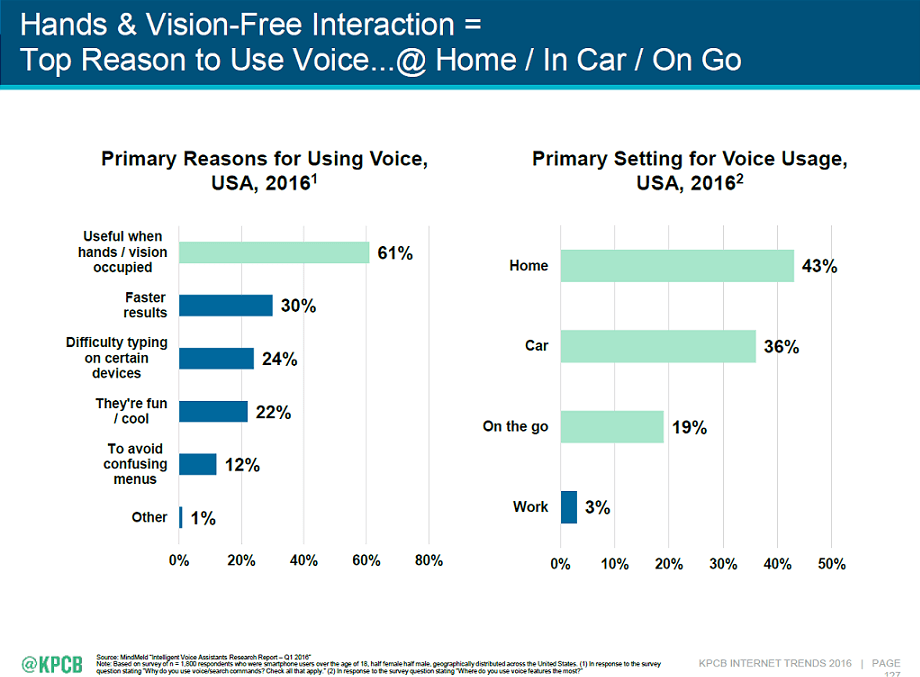 Voice search has exploded in popularity lately, with 55% of teens and 41% of adults using voice search at least once a day. ComScore predicts that 50% of all searches will be accomplished by voice search in 2020. But, how does voice search differ from visual and text search, and what does this trend mean for SEO specialists, content producers, website designers and communication professionals across the globe? In this article, we'll pass along a few tips that will help you build your voice search SEO strategy.
Voice search has exploded in popularity lately, with 55% of teens and 41% of adults using voice search at least once a day. ComScore predicts that 50% of all searches will be accomplished by voice search in 2020. But, how does voice search differ from visual and text search, and what does this trend mean for SEO specialists, content producers, website designers and communication professionals across the globe? In this article, we'll pass along a few tips that will help you build your voice search SEO strategy.
What is voice search?
Simply put, a voice search occurs when a user asks their voice assistant a question and their voice assistant reads back a single, definitive answer. Voice assistants include Apple's Siri, Google Assistant, Microsoft's Cortana, Amazon Echo and Samsung's Bixby. What's the difference between voice search and other searches? Well, a traditional text search involves users typing their queries into search engines using their laptops or mobile phones. And a visual search? Think of Pinterest, where you can click on a single Pin that you're interested in, and automatically gain access to a dizzying array of related Pins.
Why is voice search bigger than ever?
With the world becoming more fast-paced and consumers' attention spans shrinking, it's no wonder that people these days would much rather conduct a voice search than a standard text search. After all, the average person can only type 41.4 words per minute, which is far less productive than the speed at which we speak (150€“160 words per minute). On top of that, natural language processing (NLP) technology has gotten pretty advanced in the past few years, making it easier for our voice assistants to pick up and dissect our queries accurately. Fifteen years ago, word error rates were 20€“30%, which (naturally!) put off consumers from embracing the technology wholeheartedly. Today, error rates have dropped to 5.9%, which is the same as what you'd get with a human transcriber. It's no wonder that consumers are now jumping aboard the voice search bandwagon. 
How voice searches work
Let's say an iPhone user asks Siri the following question: Are frozen blueberries better than fresh blueberries? If there's a featured snippet on Google (which is the answer box located at the top of Google's result page), then Siri will read out the answer, word for word. On the other hand, if there's no featured snippet on Google, then Siri will simply state: OK, I found this on the web for "Are frozen blueberries better than fresh blueberries?€ and list the top few results. Obviously, if you can finagle your way into owning several featured snippets, then you'll stand out among your competitors.
Key features of voice searches
Voice searches are typically:
- Who, what, where, when, why or how questions
- Conversational (i.e. not formal)
- Long-tail in nature (longer, highly specific keyword phrases)
Planning your voice search SEO strategy
Before you start planning your voice search SEO strategy, it's important to get to know your audience. Apart from having access to data in terms of socio-demographics, technographics or topical interests, you'll also want to dig deep. Understand what concerns and truly motivates them and what their goals and pain points are. When you're talking to your audience, be sure to take note of the language that they use as well. If there are any specific phrases that keep popping up, jot them down. In order to come up with an effective voice search SEO strategy, you'll need to be able to mimic the language that your audience uses. (Running in the same vein: PR professionals who are versatile and can code-switch according to the situation will do well when working on voice search SEO projects). Next, map your buyer journey, and come up with a set of questions that you can work with. Let's say your client is an e-commerce platform selling Swiss skincare brands. Depending on the stage in the journey their potential customers are in, they might search for:
- How does Swiss skincare work?
- Why is Swiss skincare so popular?
- What are the best Swiss skincare brands?
- Where can you buy XYZ brand in Europe?
- Is XYZ brand better than ABC brand?
Last but not least, start optimizing your content to get those highly coveted featured snippet slots. To do this, you'll want to check out Google's Voice Search Raters guidelines.
Voice search raters guidelines
Google's voice search raters guidelines recommend that voice search results should be brief and to-the-point. Now, this is pretty much the exact opposite of what we see in traditional SEO optimization. With text-based SEO, often more is more, and the best strategy is to produce content that's up to 2,500 words. But voice search is a whole new ballgame, with the average voice search result being only 29 words long. So keep it short and sweet!
Tools and technology for voice search SEO
To fine-tune your voice search SEO strategy, updating your content is crucial, but you may also use keyword research tools to come up with more voice search questions. In particular, home in on the tools that specialize in long-tail keywords, including Keyword.io, Answer the Public or Buzzsumo's Question Analyzer.
Advanced voice search SEO tips
To really capitalize on the power of voice search, and beat out your competitors, here are a few tips to optimize your visibility in voice search results:
- Reduce your website loading speed. The typical loading speed of a voice search result is 0.54 seconds, as compared to the average website's 2.1 seconds.
- Switch to an https site. 70.4% of voice search result URLs are https, as compared to 50% of Google desktop results.
- Use simple language. The average Google voice search result was written at a reading level that's understandable to a 14-year-old.
- Be conversational. Voice search effectiveness is driven by how we speak and behave in everyday situations. So be less formal.
- Use questions and answers. Voice search queries are more often questions than statements as people tend to ask questions in natural language. Question search queries have seen exponential growth just as phrases starting with "who€ or "how.€ Exploit this trend and include targeted questions for example in the FAQ section on your website.
- Use the Skyscraper Technique to revamp existing content. If your statistics are outdated, update them! If some websites that you're linking to aren't around anymore, remove those links. The key is to keep adding to your old content and refreshing it, so that it becomes a highly valuable resource.
Measuring your voice search effectiveness: Achieve position 0'
As with SEO and optimizing pictures and videos for search engines, the effectiveness of your voice search strategy will be measured by the relevant visibility it creates. Unfortunately, as voice search is still pretty new, there aren't any tools or metrics that help PR agencies and brands measure the effectiveness of these searches. While we wait for the market to evolve, PR agencies can look to the number of featured snippets that they've obtained for a client as an initial benchmark of success. Here is an example of a featured snipped, or "position 0"
Is voice search SEO here to stay?
The voice recognition market will be worth US$601 million by 2019; moving ahead, we can expect more brands to start making voice search SEO a key part of their overall communication and marketing strategy. At the same time, companies might start experimenting with using voice search SEO to target specific audiences. Given that 56% of European physicians are either already using (or interested in using) voice search, for example, it'll be interesting to see if medical and healthcare companies can somehow leverage on this and reach out more effectively to these searchers. This article originally appeared on the Ubermetrics Technology blog. It is reposted with permission.
Falk RehkopfFalk is chief marketing officer at Ubermetrics Technologies, a leading provider of content intelligence solutions. He has extensive experience in PR tech and media intelligence, and previously served as managing director of PR software and services provider Cision Germany. Before that, Falk worked for various data, research and analysis firms such as SPSS/IBM and Forrester Research, and as a legislative assistant at the German Parliament. Connect with him on Twitter or LinkedIn.